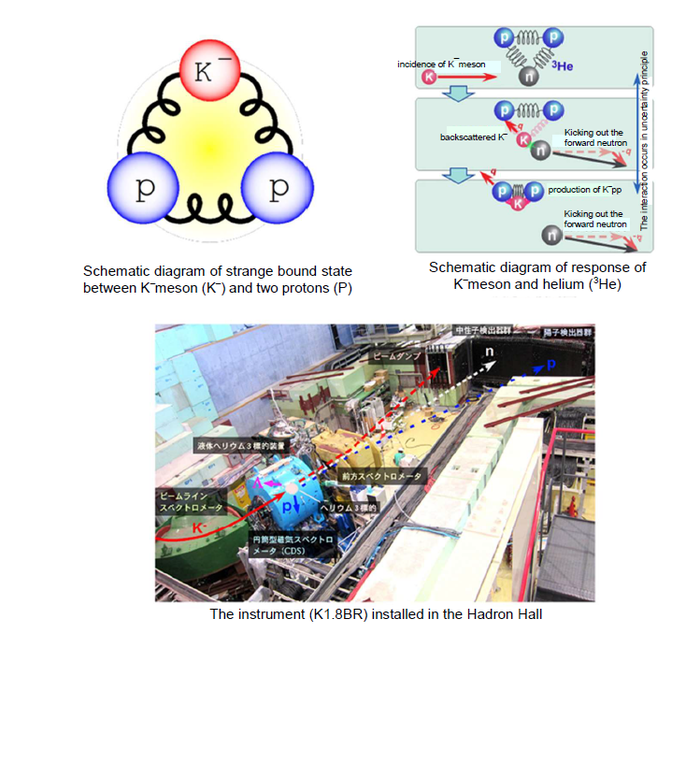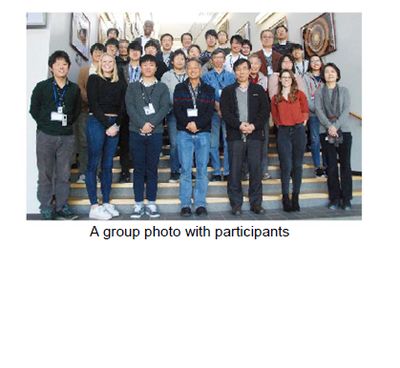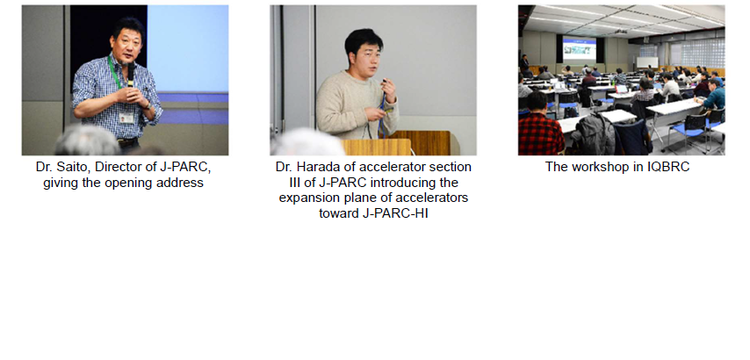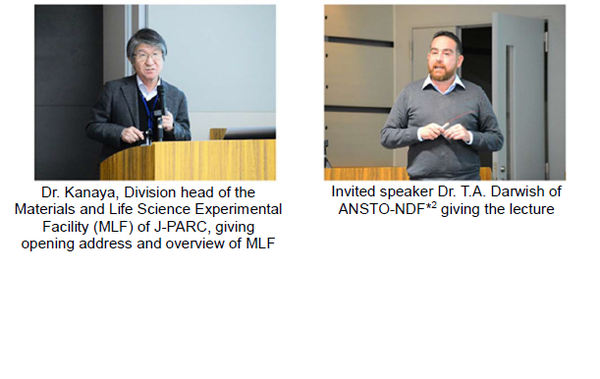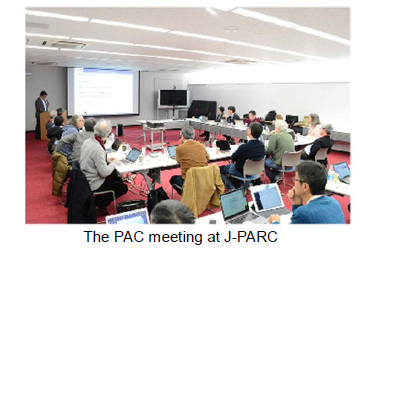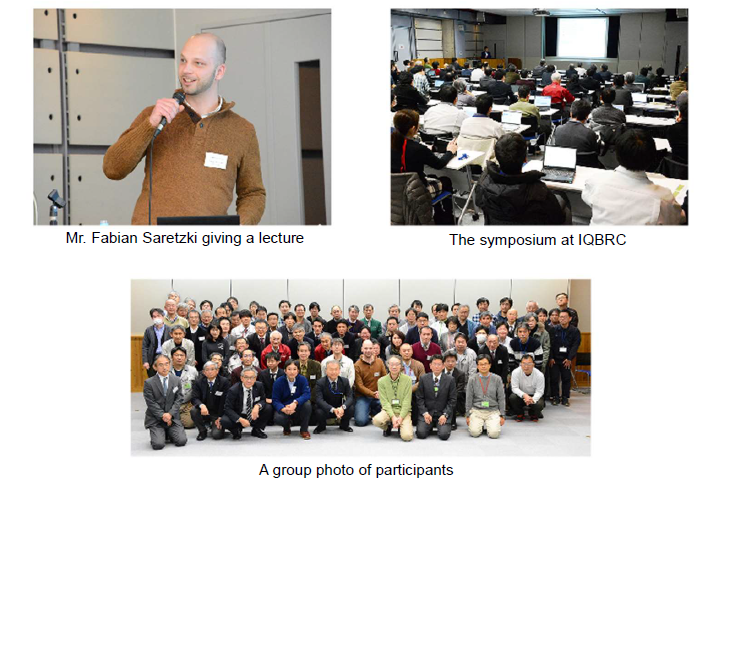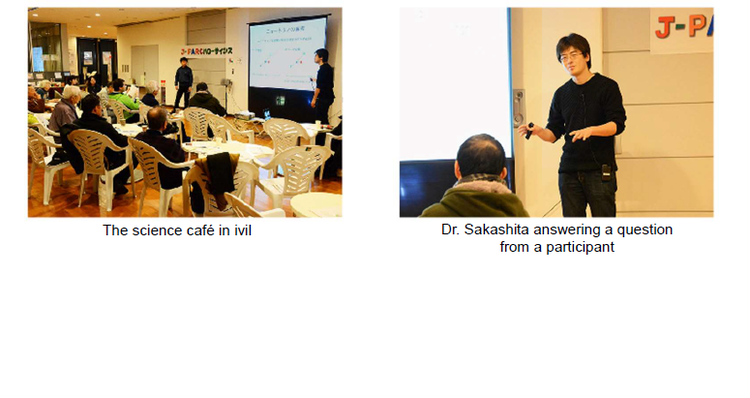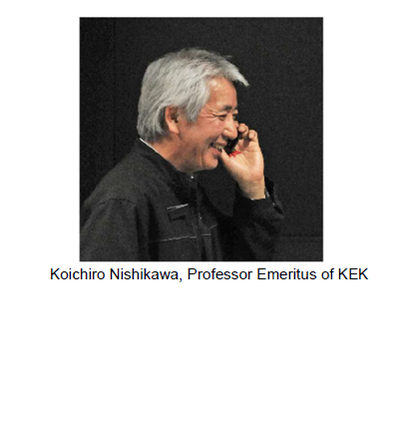J-PARC NEWS January 2019 (Issue #165)
■ Discovery of nucleus containing two protons and a kaon ~ "Exotic" bonding between anti-quark and quark pair ~ (January 24, 2019 press release)
The international Collaboration group led by RIKEN's Masahiko Iwasaki, have used J-PARC's Hadron Experimental Facility K1.8BR beam line to successfully demonstrate for the first time in the world the generation of "meson bound nuclei" in an anti-quark and quark pair. Mesons exist as "virtual particles" within an atomic nucleus, but in a vacuum have properties of "real particles" with a specific mass and life. Yet it was unclear as to whether mesons were able to become part of a nucleus with neutrons and protons while they exist as "real particles." In these experiments, a helium target containing two protons and a single neutron was bombarded with a kaonic beam to successfully form a "K-pp" meson bound nucleus." The resulting bond was thought to be compact and bound tightly, demonstrating that truly exotic high-density matter is formed spontaneously. Details of this research was first released in the January 2 online version of the European scientific journal "Physics Letters B" before appearing the printed journal.
■ J-PARC KOTO Experiment Collaboration Meeting (December 14 to 16, 2018, J-PARC)
The KOTO experiment has been running at the Hadron Experimental Facility under international collaborative research into the rare decay of neutral kaon. To promote this research, the conference is held twice a year, and 30 research members from Japan, America, Korea, Taiwan and other countries attended the conference in December 2018. Topics reported and discussed in detail at the conference included data analysis, progress of detector upgrades being made since summer last year, and data collection from beam time scheduled from February.
■ Reimei Workshop/J-PARC Workshop "J-PARC-HI opens up the Physics of High-Density Materials and Strangeness" (December 15, 2018, IQBRC)
J-PARC Center and JAEA Advanced Science Research Center is considering establishing an international research center for its "J-PARC Heavy Ion Project (J-PARC-HI)" to study the physics and strangeness of the highest density matter in the universe at J-PARC by using high forces to accelerate heavy-ion beams, which are heavier than proton beams. On December 15 last year, a workshop was held at the Ibaraki Quantum Beam Research Center (IQBRC), where leading Japanese researchers in the field of nuclear physics were invited to discuss the academic significance of this project. Around 60 researchers attended the workshop, including some joining in via TV conference from overseas, for a fruitful discussion on the progress of the project.
■ J-PARC Workshop 2018/Deuterium Labeling Study for Neutron Science (January 15 to 16, 2019, IQBRC)
Deuterium labeling*1 is a method often used in neutron research for studies in the field of life sciences and soft matter such proteins and polymers, where hydrogen in samples are replaced with heavy deuterium, as a way of focusing on target molecules. A workshop related to neutron scattering research using deuterium labeling study was held with specialists from Japan and overseas, including America's Oak Ridge National Laboratory (ORNL) and the Australian Nuclear Science and Technology Organisation (ANSTO), to discuss the latest pioneering results. J-PARC operates a deuterating laboratory that uses deuterium labeling for neutron sciences, and which played a central role in this workshop.
*1 Deuterium (D) is a stable isotope of hydrogen, and is used as an effective method in neutron experiments for understanding the role of proteins or polymers, such as studying biological organisms, analyzing structural components, and reaction mechanisms.
*2 National Deuteration Facility
■ 27th J-PARC PAC (January 16 to 18, 2019, J-PARC)
The J-PARC Program Advisory Committee (PAC) for the Nuclear and Particle Physics Experiments was held over three days from January 16. The Committee included reports and progress updates from persons in charge of research groups currently running experiments using the J-PARC Hadron Experimental Facility and Neutrino Experimental Facility, as well as reviews and screening of new experiments proposed at the facilities. Reports on the current status of J-PARC accelerators and future plans were also provided.
■ 6th Accelerator Facility Safety Symposium (January 24 to 25, 2019, IQBRC)
The 6th Accelerator Facility Safety Symposium was held on January 24 and 25 at the Ibaraki Quantum Beam Research Center (IQBRC), with some 120 participants attending from accelerator facilities in Japan and overseas. Various initiatives of each facility were introduced under the theme of personal dose management and fire emergency response at accelerator facilities, and active exchanges of views were conducted. Mr. Fabian Saretzki, in charge of safety at accelerator facilities in Germany, was invited to give a talk on fire emergency response measures, where he provided information on efforts for fire protection at European XFEL*, which operates a 3-km long accelerator tunnel. A "satellite workshop" was held on January 28 at the J-PARC Research Building covering various topics related to safety management, including evacuating from accelerator tunnels in emergency and localization of each person inside the tunnel.
* X-ray free-electron laser facility
■ J-PARC Hello Science: approaching the Mysteries of the Universe with J-PARC's Neutrinos (December 21, 2018, Tokai-village Industry and Information Plaza "iVil")
In the J-PARC Science Café in December 2018, Dr. Ken Sakashita of the Neutrino Section gave a talk about cutting-edge research using high-intensity neutrinos created artificially at J-PARC. He started talking about the relation of universe and particles, and then he explained how neutrino research works for solving of cosmogenesis to the most compelling questions that have puzzled humanity since ancient Greek times and even today - What is the world made of? How does the universe work?
He talked passionately that he wants to be able to unlock one of the great mysteries of the universe such as why antimatter disappeared in the universe, carrying on the results of studies that earned Dr. Koshiba and Dr. Kajita their Nobel Prizes.
■ Notice on the passing of former J-PARC Center Deputy Director Koichiro Nishikawa
Koichiro Nishikawa, professor emeritus of the High Energy Accelerator Research Organization (KEK), passed away in November 2018. He was a pioneer of long baseline (LBL) neutrino oscillation experiments, and proposed and oversaw the world's first LBL experiment: K2K experiment. He was also in charge of J-PARC's LBL experiment and the large international joint T2K experiment, where he headed studies into neutrino research. Nishikawa held the positions of Deputy Director of J-PARC and Director of the Institute for Particle and Nuclear physics at the KEK Laboratory, steered research efforts at J-PARC, and showed immense leadership in the wake of the 2011 Great East Japan Earthquake by quickly restoring operations of facilities. In Japan he was awarded the Nishina Memorial Prize (2005), and was recognized internationally with the Breakthrough Prize in Fundamental Physics (2016) and Bruno Pontecorvo Prize (2016).
J-PARC wishes to express its greatest appreciation to Koichiro Nishikawa for the many achievements in this field of research.

